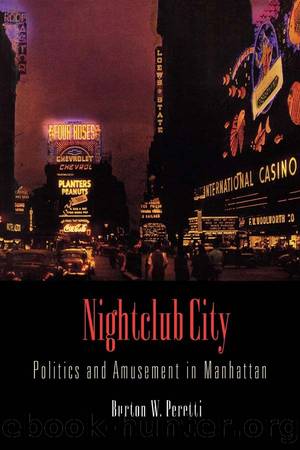Nightclub City by Burton W. Peretti

Author:Burton W. Peretti [Peretti, Burton W.]
Language: eng
Format: epub
Tags: History, United States, 20th Century, State & Local, General
ISBN: 9780812203363
Google: 3-SiODtDVvAC
Publisher: University of Pennsylvania Press
Published: 2013-04-19T01:07:30+00:00
CHAPTER 7
Nightlife in the La Guardia Era
If Robert Moses could have had his wayâand he always tried toâthe nightclub was the symbol of the Tammany era that the new reform government in New York City, taking power in 1934, would toss most forcefully onto the ash heap of history. A veteran state bureaucrat and political infighter, now Mayor Fiorello H. La Guardiaâs commissioner of city parks, Moses marked the new era in city government by plotting the razing of the Central Park Casino. To him, the old Calvert Vaux building, renovated and decorated by Joseph Urban in the 1920s and leased and operated by the Broadway restauranteur Sidney Solomon, epitomized the corruption and lost opportunities of the Jimmy Walker years.
For Moses, Walkerâs carefree nights on the Casinoâs dance floor were the antithesis of his ideal of modern leisure. As the state parks commissioner in the 1920s Moses originated pioneering projects on Long Island that revealed the basic contours of his philosophy of leisure reform. In many ways Moses was an anti-urbanist who wanted to redirect city dwellers to meticulously engineered, high-volume recreation sites on the fringes of the metropolitan region. He planned the Northern and Southern State Parkways on Long Island to be conduits for automobile excursions from the city to his new outdoor parks at Jones Beach, Valley Stream, and Hempstead. Mosesâs love of the seaâhis favorite pastime was open-water swimmingâhelped dictate an emphasis on beaches, while his progressivist faith in engineering led him to use bricks and mortar to improve on nature. Fresh air and ocean views were almost all that remained of nature once Moses was finished with his construction of paved roads and walkways, bathhouses, restaurants, playgrounds, zoos, and parking lots.1
In the 1930s, as Moses turned to reshaping recreation in New York City, he retained his goal of symbolically cleansing the masses out of doors. But the mission now was more urgent. Outdoor leisure, to Moses, was the antidote to densely packed city life. The facilities he built in the five boroughs were designed specifically to get New Yorkers out of doors and off of the streets. Moses despised the animal warmth and the decadent, multiethnic, walled-in artifice of urban leisure of the 1920s. During the opening of his new West Side Manhattan/Riverside Drive project in 1935 he mused, âI wonder sometimes whether our people, so obsessed with the seamy interior of Manhattan, deserve the Hudson [river].â Mosesâs onetime reform colleague Frances Perkins recalled that he considered the public âlousy, dirty people, throwing bottles all over Jones Beachâ¦. Itâs a great amorphous mass to him; it needs to be bathed, it needs to be aired, it needs recreation, but not for personal reasonsâjust to make it a better public.â As Robert Caroâs biography has famously shown, Mosesâs contempt for street-level urban life led him in succeeding decades to wrench people, capital, and leisure out of the five boroughs and into the wider metropolitan region. His ruthless metropolitanism set him apart from more genteel champions of regional development.
Download
This site does not store any files on its server. We only index and link to content provided by other sites. Please contact the content providers to delete copyright contents if any and email us, we'll remove relevant links or contents immediately.
Cecilia; Or, Memoirs of an Heiress — Volume 1 by Fanny Burney(32434)
Cecilia; Or, Memoirs of an Heiress — Volume 2 by Fanny Burney(31869)
Cecilia; Or, Memoirs of an Heiress — Volume 3 by Fanny Burney(31852)
The Great Music City by Andrea Baker(31340)
We're Going to Need More Wine by Gabrielle Union(18967)
All the Missing Girls by Megan Miranda(15564)
Pimp by Iceberg Slim(14393)
Bombshells: Glamour Girls of a Lifetime by Sullivan Steve(13972)
Talking to Strangers by Malcolm Gladwell(13222)
Norse Mythology by Gaiman Neil(13204)
Fifty Shades Freed by E L James(13157)
For the Love of Europe by Rick Steves(12943)
Mindhunter: Inside the FBI's Elite Serial Crime Unit by John E. Douglas & Mark Olshaker(9199)
Crazy Rich Asians by Kevin Kwan(9167)
The Lost Art of Listening by Michael P. Nichols(7406)
Enlightenment Now: The Case for Reason, Science, Humanism, and Progress by Steven Pinker(7228)
The Four Agreements by Don Miguel Ruiz(6630)
Bad Blood by John Carreyrou(6552)
Weapons of Math Destruction by Cathy O'Neil(6142)
